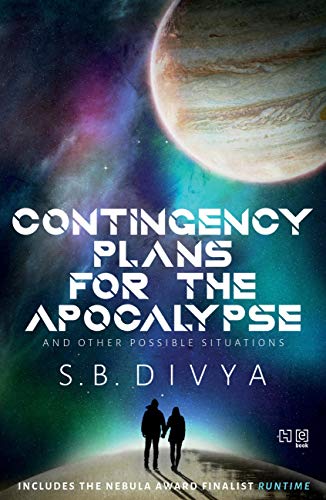Contingency Plans for the Apocalypse and other Possible Situations by S.B. Divya, author of Machinehood and Meru, is a deeply interesting collection of fourteen stories, many quite short, all of them posing life-changing choices for each central character. The prose is supple, ranging from lushly sensuous description to stripped down action. The author perfectly matches style to story and covers an impressive range. Whether taking up a few pages or novella length, S.B. Divya creates an immersive world where I immediately cared about each character.
Comparing the first two stories brings out Divya’s skill in adapting her writing to fit extremely different characters and situations. In “Loss of Signal”, a teenage boy, Toby, whose body became so crippled and useless that he chose to have his consciousness off-loaded, is off on a historic mission to the moon. His “body” is now a spaceship, yet he has brought with him the emotions of his youth. His first person narrative captures all the excitement of this adventure.
“When the doors drifted open like wings, when I trained my cameras to the star-flecked blackness, when the metal arms released me from their embrace: that was the moment my first dream came true. I checked it off the list.”
Contingency Plans for the Apocalypse…Kindle edition, Location 39
Divya captures his thrill at being able to act the part of the hero, as he recalls from his mother’s reading adventure stories aloud. His dreams, he says, are “fueled by words and pictures … You act out the scenes in your head, and you’re always the hero.” (Location 54) But then he also faces fear of failure and, like many characters in these stories, has to make a critical choice.
“Contingency Plans for the Apocalypse” is an exciting action story of the family of a doctor who performs abortions secretly in a state where the practice carries the death penalty. The story is about their long-planned escape when the military comes for them, to safe houses, tunnels, checkpoints – a shocking and unfortunately prescient story of what the future could hold. Divya’s prose captures the tension in first person narrative of every step of the escape, as a woman struggles with carrying her two children. After she scrambles down the steps to the basement getaway, she pauses.
“Once I have them both at the bottom, I allow myself a minute to breathe and listen. No sound penetrates from outside. No door slams open above us. No one shouts. I pull the kill switch in the wall – our little modification. Dirt seals off the room above. The stairs end in nothing.”
Contingencies for the Apocalypse… Kindle edition, Location 205
“Microbiota and the Masses” is about a women whose extreme sensitivities to the environment leads her to live in an airtight home where she nurtures an incredible garden. The prose is full of the sensory richness she experiences. But one day a repairman comes to the house, and her long set-aside passion for a mate fills her with a new purpose to seek him out, even if it means that her body will deteriorate when exposed to everyday pollutants. Encased in a protective suit, she ventures outside her perfect home, and her bodily senses at once take in all the noxious smells and sights:
“Bodies moved past her along the uneven slabs of the sidewalk. They stank of hot oil, sweat, sandalwood, fish, jasmine, sex. A stray dog trotted from a cluster of trash to a half-eaten banana. A fly fizzed into Moena’s ear, tickling it before moving on. How did anyone live like this? How had she, for the first twenty-three years of her life? She could almost sense the effluvia penetrating her lungs, polluting her bloodstream.”
Contingency Plans for the Apocalypse… Kindle edition, Location 455
In many of the stories the central character is dealing not just with a different or enhanced body but with the pain that accompanies either the illness that led to the physical change or the adaptation of the new form to radically changed circumstances. In “Loss of Signal” there are vivid descriptions of the phantom pain that follows the loss of bodily limbs. “Nava” is about a remote descendant of humans dealing with pain as eir body takes shape with the aid of a Maker in a far future world. When Nava tried to change eir skin, e keeps failing and collapsing into a primordial ooze. After many struggles, e makes a critical discovery about pain, that it is to be embraced.
At the heart of most of these stories are the critical choices that each character has to make to achieve their goal or even to survive. The most fully developed story that turns on moral choice is the Nebula finalist novella, Runtime. Marmeg, its central character also faces a series of choices on running a race through the mountains. She has plenty of enhancements, in the form of implanted chips and exoskeletons, but because she has no money, she has had to scrounge among trashed parts, repair them and cobble together a makeshift outfit. The prize money will solve all her problems if she can place among the lead runners, but trouble starts when some of her equipment fails and she is offered a chance to win by shady means. What will she do?
Contingency Plans for the Apocalypse and Other Possible Situations is the full title of the collection and that covers a lot of ground. But all the situations and the choices they impose are fraught with danger, pain, emotional loss or a life-changing cost. In “Ships in the Night” what happens when a woman who can foresee but never change the future, including the end of every relationship, falls in love with someone with her own disastrous history of failed relationships. That woman struggles with the knowledge that she will live forever and so outlast everyone she has ever known. What choices will they make?
In “Dusty Old Things” when electric devices start turning on and off without reason, a mother with a background in satellite communications gradually realizes that another self is getting in touch with her from a different universe. She sees that her other-me is leading a life she might have chosen, dedicating herself to a project that could bring her fame and fortune, but only at great personal cost. She is torn between her present life and a far different road not taken. What will she and her other-me do?
Every story poses a life-challenging question or requires the central character to deal with a force that could change them forever. In beautiful prose that is carefully adapted to the tone of each story and each character’s life, Divya proves herself a master of the shorter fictional forms.





Leave a Reply